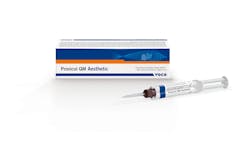I have it—you want it! Provicol QM Aesthetic
Way back in dental school, the only temporary cement we had was zinc oxide/eugenol. Over my last 46 years of clinical practice, I cannot begin to count how many cements have been launched for provisional restorations with and without the tried-and-true zinc oxide/eugenol combination. Voco has a great new translucent, zinc oxide, non-eugenol, temporary cement that contains calcium hydroxide called Provicol QM Aesthetic (QM stands for quick mix versus automix).
There are five key advantages to this radiopaque cement: 1) zinc oxide has antibacterial prop-erties; 2) the calcium hydroxide will help develop tertiary dentin while reducing hypersensitivity; 3) it is translucent, so there is no white bleed-through in anterior provisional restorations due to its proprietary glass matrix of polyhedral particle; 4) it has semielastic consistency, which facilitates cleanup; and 5) it will not bond to composite resin core buildups. I have found the temporary crowns are well retained (due to a low 7 μm film thickness) and easily removed. In fact, you can use this as “squirt and shoot” temporary filling in small class I cavity preps, in addition to the more common use with inlays/onlays, crowns, veneers (especially since it is translucent), and bridges. This is an excellent material and a great partner to Voco’s terrific provisional material, Structur 3.
Howard Glazer, DDS, FAGD, is a columnist for Dental Economics. He is a key opinion leader in dental products and maintains a general practice in Fort Lee, New Jersey. Dr. Glazer is a fellow and past president of the Academy of General Dentistry (AGD). He lectures frequently on the subjects of dental materials, cosmetic dentistry, forensic dentistry, and patient management.
About the Author

Howard S. Glazer, DDS, FAGD
Howard S. Glazer, DDS, FAGD, is a fellow of the Academy of General Dentistry, American College of Dentists, International College of Dentists, American Society for Dental Aesthetics, American Academy of Forensic Sciences, and a diplomate of the American Board of Aesthetic Dentistry. He is an attending dentist at the Englewood Hospital in Englewood, New Jersey, and the deputy chief forensic dental consultant to the Office of Chief Medical Examiner, City of New York.
